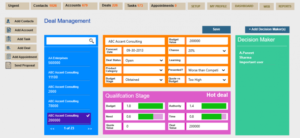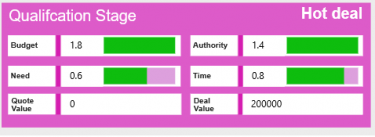Forecasting sales with confidence
Is forecasting sales a matter of guesswork? Or is it scientific, based on rules and mathematically modeled?
The answer is that it is somewhere in between. Let me take a shot at sharing some simple yet effective funnel management best practices. When you are a small business, you need to forecast sales and collections, to be able to keep on top of cash flow, deliveries and other commitments.
How does Saleswah help you forecast?
Let me first bring in the concept of a “weighted funnel”.
Let us say you had a few deals you were working on. And they looked like this:

How much should you forecast for the next month?
The value of the forecast for next month (that is January 2013), seeing that it is December 2012 when I am writing this, will be $41,000.
However, we all know that we rarerly, if ever, win 100% of deals- there is competition, fickle minded customers, economic uncertainty etc. Some cause deals to “drop” out of the funnel – read cancelled/ lost- and some cause them to be moved to the next month.
Let us get the salesman to apply his mind and commit a win probability number to all the deals.
As you can see, the picture does not look quite so good any more :), though it is probably more realistic. Specifically, if you go by this measure, the Dec’12 numbers have dropped to 32,000 from 46,000 and January ’13 numbers have dropped to 21,000 from 41,000.
“Oh, but, this is all subjective: based on an individual salesman’s assessment”
Agreed. That is why, we also track the stage of qualification on every deal. Like this:

What does Saleswah capture?
1. Has the solution been presented? (Choices: No; Yes it was and was found- better than/ same as/ worse than competition).
2. Budget Stage: No status/ Planning/ Applied For/ Obtained. Also, Budget value
3. If a quote has been sent (Incidentally, you can configure and send a quote directly from Saleswah and have the quote “attached” to the deal), then:
– is the customer’s budget less than or more than what you have quoted?
Why do we not include the deal stage in the “weighted funnel” calculations as above?
Couple of reasons. Firstly, as with the chance of win, these stages are also captured by individual sales executives and can have their share of biases and buffers. Secondly, we provide these fields for exectives to do a reality check before committing the forecast numbers. And, for their managers to review as well. After all, a deal where you have not yet met the decision makers to discuss the solution, is unlikely to close early and forecasting a 80% confidence level in a win is foolhardy.
Should we include these in forecasting as well? What do you think? Tell us in comments below.
